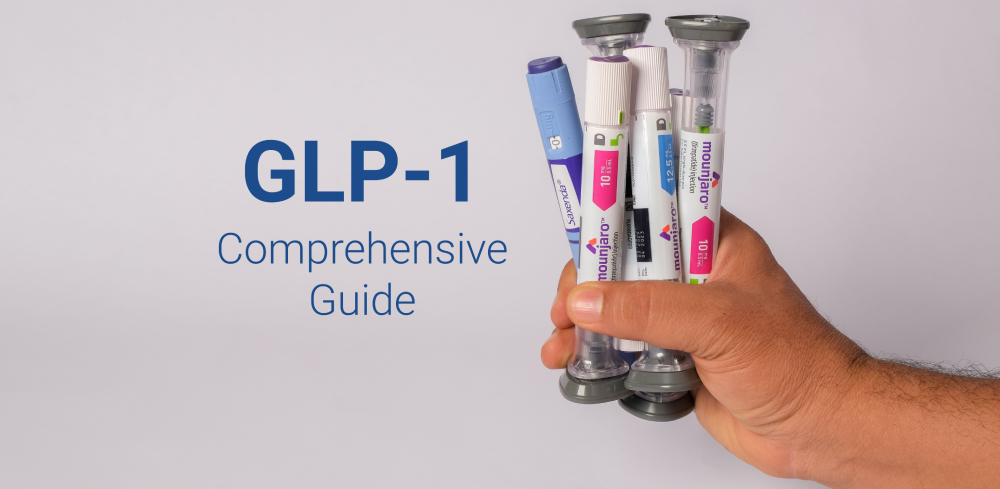Introduction to the GLP-1 Diet
The GLP-1 diet revolves around the utilization of glucagon-like peptide-1 (GLP-1), a hormone that plays a critical role in regulating appetite and glucose metabolism in the body. GLP-1 is secreted in response to food intake and serves multiple functions, including enhancing insulin secretion when glucose levels are elevated and reducing appetite by promoting satiety. This diet is grounded in the premise that by harnessing the effects of GLP-1, individuals can achieve weight loss and improve their glycemic control, making it particularly popular among those with type 2 diabetes and obesity.
One of the primary features of the GLP-1 diet is its emphasis on foods that naturally stimulate GLP-1 release. These foods often have a high fiber content and a low glycemic index, encouraging stable blood sugar levels while simultaneously promoting feelings of fullness. In conjunction, medical interventions such as GLP-1 receptor agonists may also be utilized to enhance the diet’s effectiveness, aiding in the regulation of blood glucose and contributing to weight loss goals.
The growing popularity of the GLP-1 diet can be observed in various health and wellness circles, with increasing numbers of individuals exploring it as a viable option for weight management and diabetes control. However, despite its appeal, it is crucial to consider potential drawbacks associated with this dietary approach. While many may find success, not everyone experiences the same results, and negative effects can arise from its implementation. The following sections will delve into these adverse effects, shedding light on important considerations for those contemplating the GLP-1 diet.

Common Negative Side Effects of the GLP-1 Diet
The GLP-1 diet, which leverages the benefits of Glucagon-Like Peptide-1 (GLP-1) to aid in weight management and metabolic control, can come with several notable side effects. One of the most frequently reported issues is gastrointestinal discomfort. This often manifests as nausea, vomiting, or diarrhea, primarily due to the changes in digestive processes caused by GLP-1 receptor agonists. As the body adjusts to altered digestion, these symptoms can occur. The frequency of such side effects varies from person to person, with some individuals experiencing them more severely than others.
Another common side effect associated with the GLP-1 diet is the alteration of appetite. While many individuals may find that their food cravings diminish, some may also experience loss of appetite. This can complicate meal planning and nutrition balance, as a loss of appetite may lead to inadequate caloric intake over time. Understanding how the GLP-1 hormone affects hunger signals is essential for those considering this dietary approach, as it may promote unintended weight loss in susceptible individuals.
Additionally, there are implications for metabolism when adopting the GLP-1 diet. While the intent is often to enhance metabolic function, some users report feelings of fatigue or sluggishness, which may stem from an initial adjustment period as the body adapts to the hormonal shifts induced by GLP-1. It is crucial to monitor these symptoms closely. While they can generally be managed through gradual adjustments in diet and lifestyle, consulting a healthcare professional is recommended to ensure these negative effects do not compromise overall health.
Managing these side effects typically involves small dietary adjustments, such as incorporating high-fiber foods to alleviate gastrointestinal distress, and maintaining hydration. Additionally, educating oneself about the GLP-1 diet and potential changes in body’s response is vital for successfully navigating these challenges.

Long-term Health Risks Related to the GLP-1 Diet
The GLP-1 diet, designed to exploit the benefits of glucagon-like peptide-1, has garnered attention for its potential in weight management and glycemic control. However, it is essential to consider the long-term health risks that may arise from its sustained implementation. One of the primary concerns is the risk of nutrient deficiencies, as individuals following this diet may limit their intake of various food groups. This restriction can lead to insufficient vitamins, minerals, and other essential nutrients necessary for optimal bodily function, potentially resulting in adverse health outcomes such as anemia, weakened immunity, and bone health issues.
Another critical aspect to consider is the impact of the GLP-1 diet on thyroid function. Some studies suggest that prolonged suppression of caloric intake may affect thyroid hormone levels, which are crucial for regulating metabolism. Abnormal thyroid function can lead to conditions such as hypothyroidism, characterized by fatigue, weight gain, and depression, exacerbating the challenges faced by individuals on this restrictive diet. Monitoring thyroid health becomes imperative for those adhering to the GLP-1 diet, particularly for extended periods.
Furthermore, there are growing concerns regarding pancreatic health linked to the long-term usage of GLP-1 agonists, a common feature of this diet. Research indicates that chronic stimulation of pancreatic functions may lead to complications such as pancreatitis or even pancreatic cancer in susceptible individuals. Given these potential risks, it becomes evident that medical supervision is not merely an option but a necessity for anyone considering or currently following the GLP-1 diet. Regular check-ups can help mitigate these risks through monitored dietary adjustments and health assessments, ultimately ensuring a balanced approach to weight management while safeguarding overall health.

Tips for Safely Implementing the GLP-1 Diet
Implementing the GLP-1 diet can be beneficial for weight management and overall health; however, it is essential to approach it with caution. Here are some practical tips to help individuals safely adopt this dietary approach while minimizing any potential negative effects.
Firstly, monitoring your health should be a priority while on the GLP-1 diet. Keeping a detailed journal of your food intake and any physical responses will help identify how your body reacts. Regularly noting parameters such as weight, blood glucose levels, and overall energy can aid in recognizing any signs of distress early on. If you experience unusual symptoms like severe gastrointestinal discomfort, excessive fatigue, or dizziness, it is important to evaluate your diet and consult a healthcare professional.
Additionally, awareness of the signs indicating negative effects of the GLP-1 diet is crucial. Look out for signs such as persistent nausea, loss of appetite, or digestive disturbances that do not seem to ease with time. These symptoms could suggest an imbalance in nutrient intake or an adverse reaction to the dietary changes introduced through GLP-1 agonists. If these signs persist, seeking medical guidance is strongly advised, as a healthcare professional can provide personalized recommendations tailored to your needs.
Moreover, incorporating balanced nutrition along with the GLP-1 diet can further optimize its benefits. Focus on consuming a variety of whole foods, including vegetables, lean proteins, and healthy fats, ensuring you meet all essential nutrient requirements. Regular physical activity can also complement the dietary changes effectively; aim for at least 150 minutes of moderate exercise each week to enhance weight loss and improve overall health outcomes while on the GLP-1 diet.










